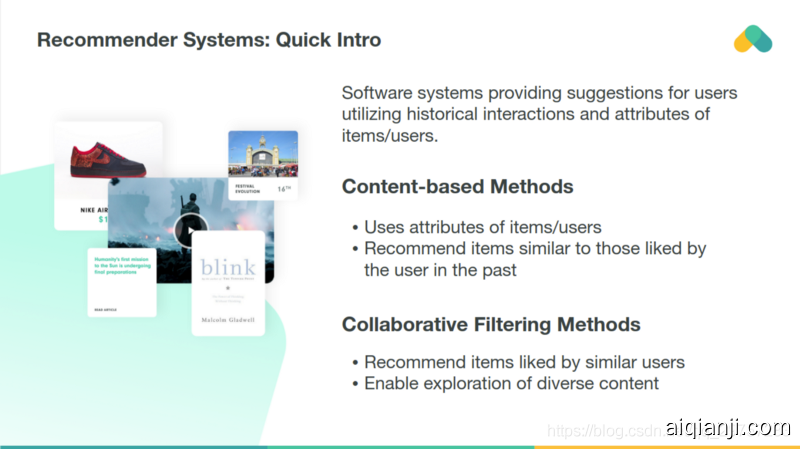Machine Learning for Recommender systems — Part 1 (algorithms, evaluation and cold start)
Recommender systems are one of the most successful and widespread application of machine learning technologies in business. There were many people on waiting list that could not attend our MLMU talk so I am sharing slides and comments here.
引言

You can apply recommender systems in scenarios where many users interact with many items.
你可以在许多用户与项目交互的场景中应用推荐系统。

You can find large scale recommender systems in retail, video on demand, ormusic streaming. In order to develop and maintain such systems, a company typically needs a group of expensive data scientist and engineers. That is why even large corporates such as BBC decided to outsource its recommendation services.
你可以在零售、视频点播或音乐流中找到大型推荐系统。为了开发和维护这样的系统,公司通常需要一群昂贵的数据科学家和工程师。这就是为什么即使是像BBC这样的大公司也决定外包其推荐服务的原因。

Our company Recombee is based in Prague and develops an universal automated recommendation engine capable of adapting to business needs in multiple domains. Our engine is used by hundreds of businesses all over the world.

Surprisingly, recommendation of news or videos for media, product recommendation or personalization in travel and retail can be handled by similar machine learning algorithms. Furthermore, these algorithms can be adjusted by using our special query language in each recommendation request.
Algorithms 算法

Machine learning algorithms in recommender systems are typically classified into two categories — content based and collaborative filtering methods although modern recommenders combine both approaches. Content based methods are based on similarity of item attributes and collaborative methods calculate similarity from interactions. Below we discuss mostly collaborative methods enabling users to discover new content dissimilar to items viewed in the past.
推荐系统中的机器学习算法通常分为两类:基于内容的推荐方法和协同过滤方法,尽管现代推荐者将这两种方法结合在一起。基于内容的方法是基于项目属性的相似性和协作方法,从交互中计算相似度。下面我们主要讨论协同过滤方法,使用户能够发现与过去查看过的项目不同的新内容。

Collaborative methods work with the interaction matrix that can also be called rating matrix in the rare case when users provide explicit rating of items. The task of machine learning is to learn a function that predicts utility of items to each user. Matrix is typically huge, very sparse and most of values are missing.
协同过滤方法与交互矩阵一起工作,当用户提供项目的显式评分时,这种交互矩阵也可以称为评分矩阵。机器学习的任务是学习一个函数,它可以预测项目对每个用户的效果。矩阵通常很大,非常稀疏,而且大多数值都丢失了。

The simplest algorithm computes cosine or correlation similarity of rows (users) or columns (items) and recommends items that k — nearest neighbors enjoyed.
最简单的算法是计算行(用户)或列(项)的余弦或其他相关相似性,并推荐k个最近邻居喜欢的项。

Matrix factorization based methods attempt to reduce dimensionality of the interaction matrix and approximate it by two or more small matrices with k latent components.
基于矩阵因式分解的方法试图降低相互作用矩阵的维数,并将其近似为两个或多个具有k个潜在分量的小矩阵。

By multiplying corresponding row and column you predict rating of item by user. Training error can be obtained by comparing non empty ratings to predicted ratings. One can also regularize training loss by adding a penalty term keeping values of latent vectors low.
通过将相应的行和列相乘,你可以根据用户预测项目的评分。训练误差可以通过比较非空评分和预测评分来获得。还可以通过增加惩罚项,保持潜在向量的低值来调整训练损失。

Most popular training algorithm is a stochastic gradient descent minimizing loss by gradient updates of both columns and rows of p a q matrices.
最流行的训练算法是随机梯度下降算法,通过对p q矩阵的列和行进行梯度更新,使下降损失最小化。

Alternatively, one can use Alternating Least Squares method that iteratively optimizes matrix p and matrix q by general least squares step.
或者,可以使用交替最小二乘法,通过一般最小二乘步骤迭代优化矩阵p和矩阵q。

Association rules can also be used for recommendation. Items that are frequently consumed together are connected with an edge in the graph. You can see clusters of best sellers (densely connected items that almost everybody interacted with) and small separated clusters of niche content.
关联规则也可用于推荐。经常在一起消费的项目与图形中的边缘相关联。你可以看到一组畅销书(几乎每个人都与之交互的紧密连接的项目)和小的、分离的内容集群。

Rules mined from the interaction matrix should have at least some minimal support and confidence. Support is related to frequency of occurrence — implications of bestsellers have high support. High confidence means that rules are not often violated.
从交互矩阵中挖掘出的规则至少应该有一些最小的支持度(support)和置信度(confidence)。支持度与发生频率有关,比如畅销书有很高的支持度。高置信度意味着规则不会经常被违反。

Mining rules is not very scalable. The APRIORI algorithm explores the state space of possible frequent itemsets and eliminates branches of the search space, that are not frequent.
挖掘规则的规模不大,先验算法探索了可能的频繁项集的状态空间,消除了搜索空间中不频繁的分支。

Frequent itemsets are used to generate rules and these rules generate recommendations.
频繁项集用于生成规则,这些规则产生推荐。

As an example we show rules extracted from bank transactions in the Czech Republic. Nodes (interactions) are terminals and edges are frequent transactions. You can recommend bank terminals that are relevant based on past withdrawals / payments.
例如,我们展示了从捷克共和国的银行交易中提取的规则。节点(交互)是终端,边缘是频繁的交易。你可以根据过去的取款/付款推荐相关的银行终端。

Penalizing popular items and extracting long tail rules with lower support leads to interesting rules that diversify recommendations and help to discover new content.
惩罚受欢迎的项目和提取支持度较低的长尾规则会产生有趣的规则,使推荐多样化并有助于发现新的内容。

Rating matrix can be also compressed by a neural network. So called autoencoder is very similar to the matrix factorization. Deep autoencoders, with multiple hidden layers and nonlinearities are more powerful but harder to train. Neural net can be also used t
